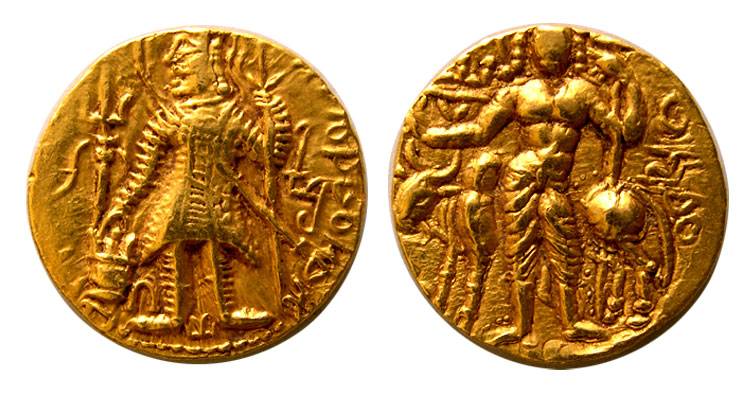

Source: http://www.vcoins.com/ancient/parscoins/store/viewItem.asp?idProduct=2907&large=1
(downloaded May 2006)
"Kushans. Kanishka II. Circa 200-222 AD. AV Dinar (7.85 gm; 20 mm). King standing left, holding trident, sacrificing at altar; symbols in field / Siva standing facing, the bull, Nandi, standing left behind."

Another variant of the same kind of Shaivite coin design by Kanishka II
Source: http://www.vcoins.com/ancient/parscoins/store/viewItem.asp?idProduct=3527&large=1
(downloaded Oct. 2006)
"Kings of Kushan. Kanishka II. Circa 200-222 AD. Gold Stater (7.92 gm; 20 x 21 mm). King standing left, holding trident, sacrificing at altar; symbols in field / Siva standing facing, the bull, Nandi, standing left behind."
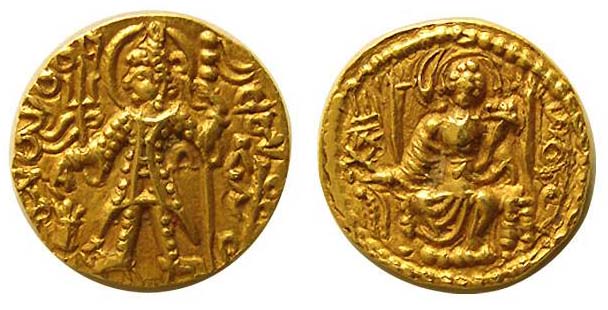
A coin by Vasudeva II (r. c.290-310) that honors the Central Asian goddess Ardoxho
Source: http://www.vcoins.com/ancient/parscoins/store/viewItem.asp?idProduct=2712&large=1
(downloaded May 2006)
"Kushan Kings of India: Vasudeva II, 260-300 AD. Gold stater (7.78 gm; 20 mm) King standing left at the altar / Goddess Ardoksho seated facing.."

A coin by Vasudeva II (r. c.290-310) honoring Shiva
Source: http://www.vcoins.com/ancient/beastcoins/store/viewitem.asp?idProduct=8048
(downloaded Apr. 2008)
"Vasu Deva I [sic.], AV Dinar, c.290-310, Kushan Kingdom. Vasudeva, nimbate, diademed, and crowned, standing facing, head left, sacrificing over altar to left, holding trident in left hand, filleted trident at left, nandipada at right, three pellets between legs, pellet in upper left field, three pellets in lower left field, three pellets in upper right field. Siva standing facing, crescent on brow, diadem in right hand, trident in left hand, Nandi bull standing left behind; tamgha in upper left field, three pellets in lower left field, all in large dotted border."

Another Shaivite design by Vasudeva II
Source: http://www.vcoins.com/ancient/gaultcoins/store/viewItem.asp?idProduct=159&large=1
(downloaded Oct. 2006)
"Kushans. Vasudeva II, ca. AD 270-310. Gandhara mint. AV Dinar. Obverse: King standing left, holding trident and sprinkling incense on altar. Trident in left field. Bactrian Greek inscription. Brahmi letters Rada, Gho and Raja in right field and below. Reverse: Shiva (Oesho) standing facing, holding trident. Bull Nandi behind, standing left, head facing. Dotted border. Weight: 7.81 grams. Diameter: 23 mm."
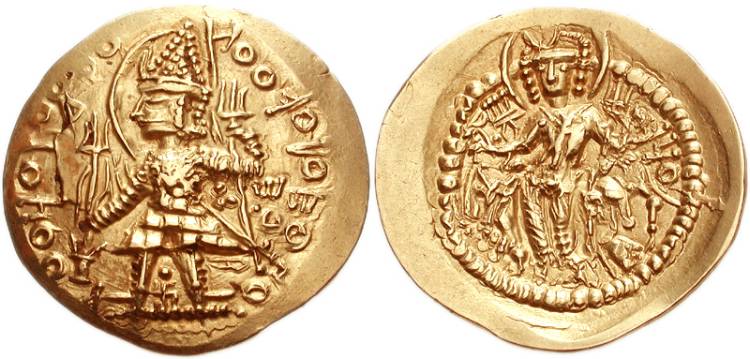
Another such Shaivite coin, in almost perfect condition
Source: http://www.vcoins.com/ancient/cng/store/viewitem.asp?idProduct=5831
(downloaded June 2008)
"Kushan Empire. Vasudeva II. Circa AD 290-310. AV Dinar (28mm, 7.89 g, 12h). Mint III (C). Vasudeva, nimbate and helmeted, standing facing, head left, sacrificing over altar and holding trident; to left, symbol above filleted trident; to right, Buddhist Triratana (“Three Jewels”); • above swastika between Vasudeva's feet; \, beneath his left arm; horizontal B in lower right field below tunic // Siva (resembling the king) standing facing, holding diadem and trident; behind, the bull Nandi standing left; above, • and tamgha to left, \ below head of Nandi. MK 689. EF, Rare with B symbol on obverse."
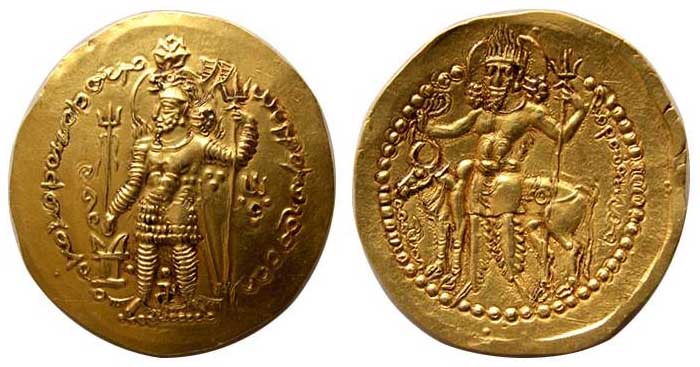
The contemporary "Kushano-Sasanian" king to the west, in the late 200's, also issued Shaivite coins
Source: http://www.vcoins.com/ancient/parscoins/store/viewitem.asp?idProduct=4337
(downloaded Feb. 2007)
"INDIA, Kushano-Sasanian: Hormizd I Kushanshah. Circa 270-295 AD. Gold Dinar (7.91 gm; 28x30 mm). Balkh mint. King standing left, wearing lion-headed crown, flames at shoulders, holding trident and sacrificing at altar; symbols in fields / Siva (resembling the king) standing facing, holding trident, the bull Nandi behind."
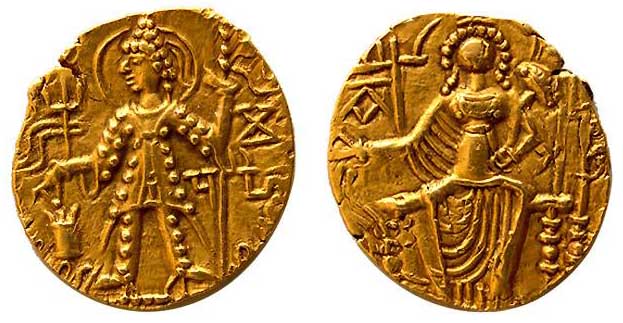
A gold stater coined by Mahi, c.320, honors Ardokho and uses Brahmi script
Source: http://www.vcoins.com/ancient/parscoins/store/viewItem.asp?idProduct=3522&large=1
(downloaded Aug. 2006)
"Kings of Kushan. Mahi. Circa 320 AD. Gold Stater (7.69 gm; 19 x 21 mm). King standing left, making offerings to small altar left, holding garlanded standard right, trident above altar, Brahmi letter under right arm, and "Mahi" in right field; rev. goddess Ardoksho enthroned facing, holding cornucopia, tamgha top left."
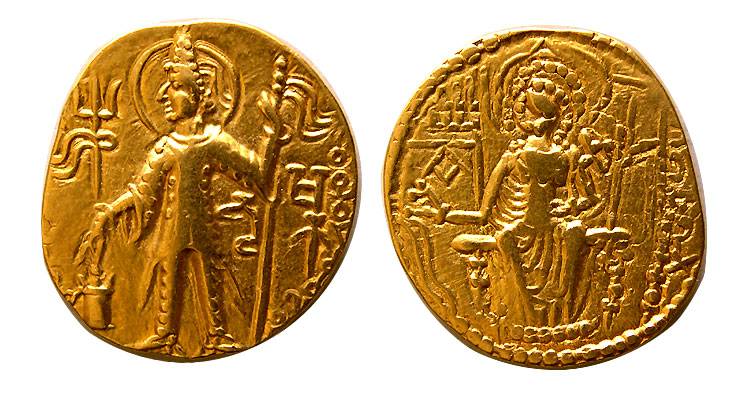
Source: http://www.vcoins.com/ancient/parscoins/store/viewItem.asp?idProduct=2908&large=1
(downloaded May 2006)
"Later Kushans. Aya-Shaka. Circa 310-345 AD. Gold Dinar (7.69 gm; 20 mm). King standing with trident and banner / Goddess Ardoksho seated facing."

While Shiva was honored as far west as Afghanistan, a Central-Asian-style goddess was honored in the Samatata kingdom, in what is now southeastern Bangladesh
Source: http://www.vcoins.com/ancient/coinindia/store/viewitem.asp?idProduct=305
(downloaded July 2007)
"KINGS of SAMATATA: Vira Jadamarah Gold dinar, 2nd-3rd century. Obverse
Kanishka-style King standing facing, sacrificing at altar at left,holding
trident in left hand, unclear Brahmi legend around: Jadayuman (?). Reverse
Ardochsho or Nana style Goddess standing right, nimbate, holding protome
of animal, Brahmi legend at left: Vira Jadamarah, tamgha at right. Date
c. 2nd-3rd CE. Weight 6.59 gm. Diameter 21 mm. Comments
The Vira Jadamarah coinage seems to follow the Kanishka imitation coins,
or may be contemporaneous with them, but issued further east. When Mitchiner
wrote his book, Land of Water, in 2000, he noted that only two Vira Jadamarah
coins were known. Since then, a few more have appeared, but they are still
extremely rare."
| == INDIAN ROUTES index == sitemap == Glossary == FWP's main page == |